I’m finally writing my toilet post. We’ve been here a year now so I’ve been thinking about it that long. Gomen nasai (sorry), but I’ve got a year’s worth of thoughts to write about. There’s just too much to say about toilets/sinks/bathrooms in Japan. There are two kinds of toilets in the ladies room here: Japanese toilets and Western toilets. Maybe Asian toilets are not a surprise to some people. But they were a surprise to me when we vacationed in Japan in 2013.
A lot of people told me beforehand that I should always carry a pack of tissues with me just in case I needed them in the public bathrooms. That advice was drilled into me as a top concern. However, no one said Japanese toilets are going to look like a horizontal urinal without instructions. Strangely enough, they are often pink colored.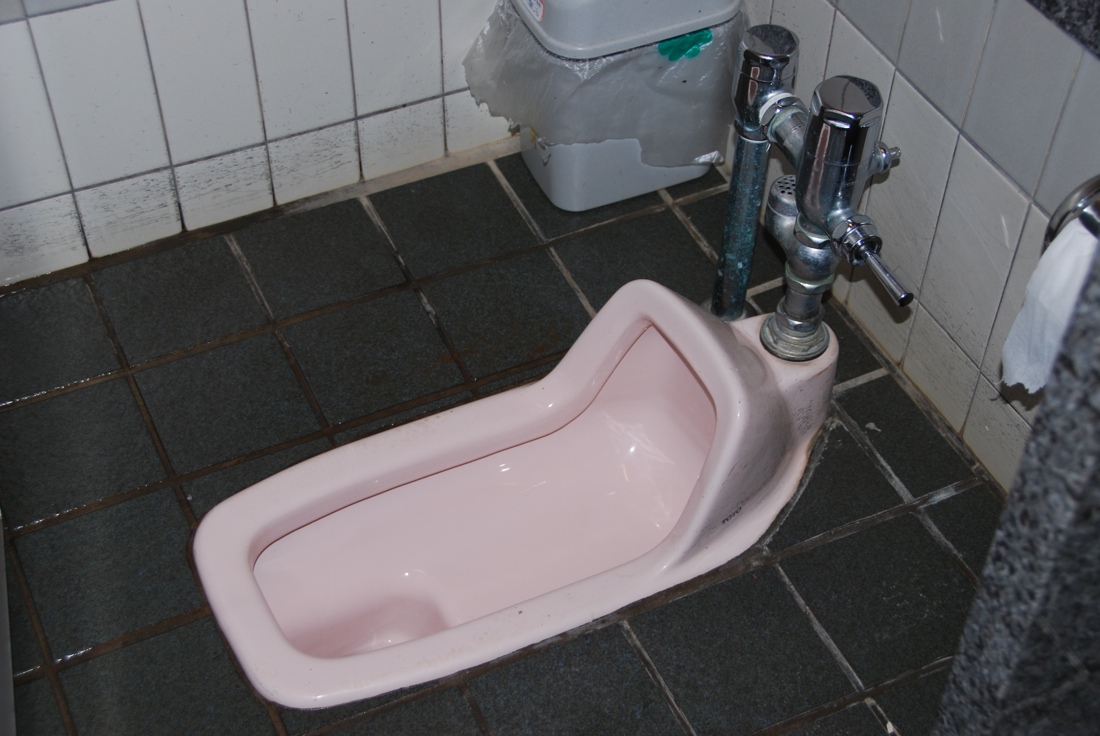 I did come to Japan in 1991 as a college student. I have no recollection of the public toilets. My home stay family had a fancy Western style house and maybe they sheltered me from Japanese toilets. Ha ha.
I did come to Japan in 1991 as a college student. I have no recollection of the public toilets. My home stay family had a fancy Western style house and maybe they sheltered me from Japanese toilets. Ha ha.
One thing that never ceases to amaze me is when a woman who is really dressed up, with a long skirt, clunky jewelry, stockings and high heels has a choice as to whether to use a Japanese toilet or Western toilet and she chooses the Japanese toilet. I mean, if you have a choice, wouldn’t it be better not to risk an accident in your fancy clothes?
Most of the time there are stalls with both kinds of toilets. And little pictures outside the door so you can tell which type of toilet is in the stall.
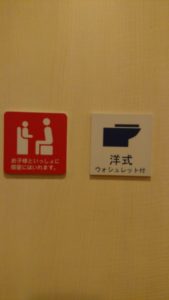
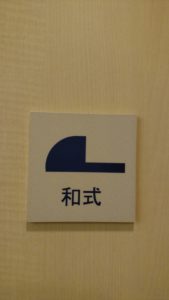 A “Western toilet” in Japan is typically a bidet. Which means it’s a toilet with a lot of little buttons and you would think since it’s “Western” there would be instructions in a language that “Westerners” can understand. But it’s mostly Japanese characters, and that makes usage of the bidet a very tricky and risky business.
A “Western toilet” in Japan is typically a bidet. Which means it’s a toilet with a lot of little buttons and you would think since it’s “Western” there would be instructions in a language that “Westerners” can understand. But it’s mostly Japanese characters, and that makes usage of the bidet a very tricky and risky business.
The spray that shoots out of the toilet reminds me exactly of the scene in Austin Powers: International Man of Mystery, when the Fembots are shooting at him with the gun barrels sticking out of their boobs. I mean, the spray mechanism comes out and looks just like that, and aimed right at you. So that’s unsettling. There’s just way too many buttons!
This panel is from our house toilet: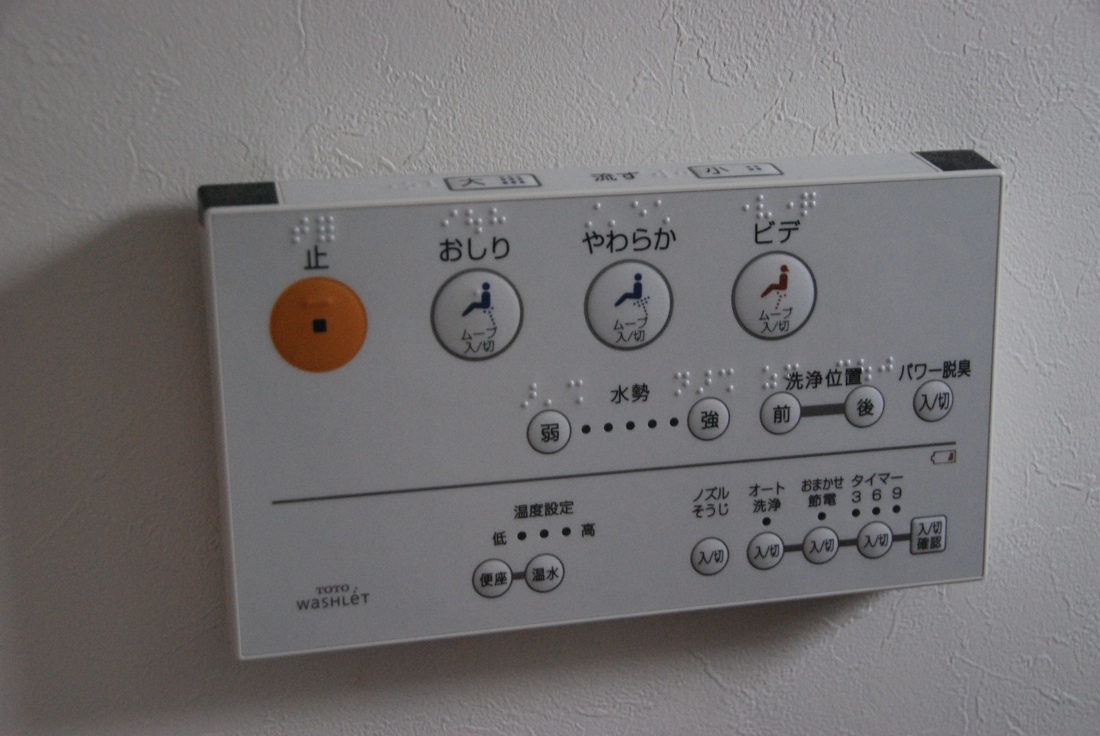 I haven’t tried the bidet much, especially in a public restroom. I just don’t want to get all wet with water coming out of the toilet. It’s seriously like a water gun. As you can see from the little figures on the toilet panel, you can choose which direction the spray comes at you. You can also choose the spray strength and “wind” or air strength for the dryer function. I believe there’s a “timer” button and a “massage” button here? Not really sure what they mean. Oh there’s also the buttons to flush the toilet. There are two choices. Big flush and little flush.
I haven’t tried the bidet much, especially in a public restroom. I just don’t want to get all wet with water coming out of the toilet. It’s seriously like a water gun. As you can see from the little figures on the toilet panel, you can choose which direction the spray comes at you. You can also choose the spray strength and “wind” or air strength for the dryer function. I believe there’s a “timer” button and a “massage” button here? Not really sure what they mean. Oh there’s also the buttons to flush the toilet. There are two choices. Big flush and little flush.
I have accidentally pushed the wrong thing when I’ve meant to flush and instead water comes squirting out everywhere. Then you have to just jump out of the way and let the walls get all wet. I try not to let that happen because the person that walks in after you is wondering what you were doing in there.
This panel is from Starbucks’ toilet: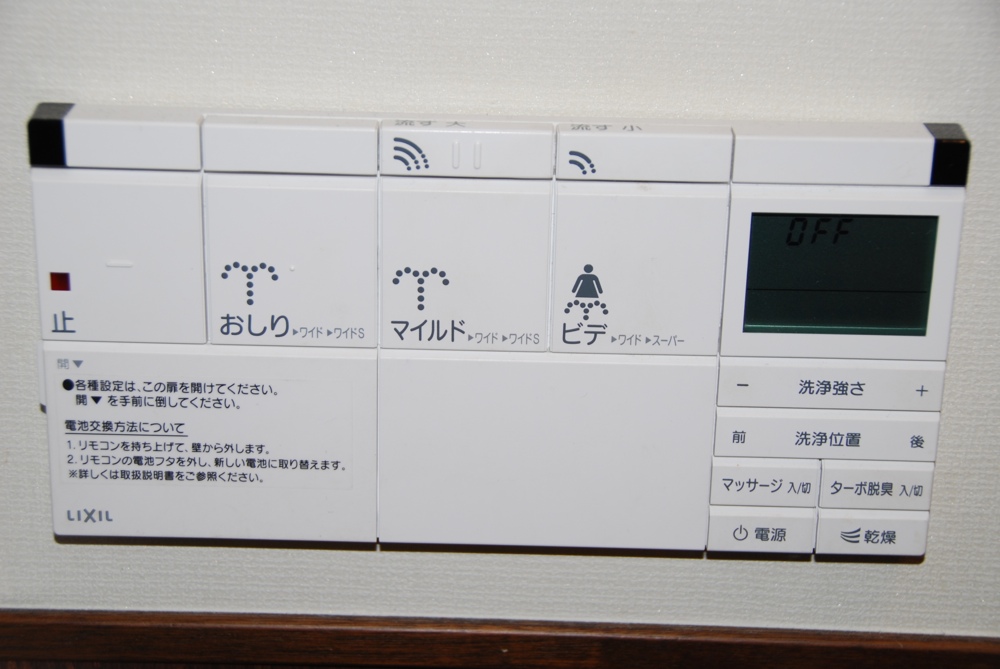 One time one of my kids was in a public bathroom, trying figure out how to flush and instead pushed the emergency help button. I think we were in the train station. An attendant came running and we had to try to explain that we just wanted to flush the toilet.
One time one of my kids was in a public bathroom, trying figure out how to flush and instead pushed the emergency help button. I think we were in the train station. An attendant came running and we had to try to explain that we just wanted to flush the toilet.
One common button that’s nice is the innocent music selection, which typically plays the sound of a gushing waterfall. It’s meant to cover up whatever noises you are making in the stall. Sometimes it’s Mozart or Beethoven, but usually it’s the sound of running water. This button should be easy to find because it often has a music note on it. I also like the setting that heats up the toilet seat in winter, though a lot of toilets do this automatically. It’s really annoying when the toilet seat is boiling hot in summer. That doesn’t happen too often so there must be a way to shut off the heat option in summer.
One time we were at Expo City Mall and I noticed just inside the bathroom door, when you first enter, there is a map on the wall showing the bathroom layout. It’s not a huge bathroom, like at the airport, but it’s a picture diagram that shows which stalls are Japanese, which are Western, which ones have baby changing stations, where the sinks are, etc. Awesome, a toilet map.
Back to the Japanese toilet. If you’ve grown up in Japan you’re used to this. It’s not strange or puzzling. You know which direction to face and what to do. But a urinal in any position should just stay over in the men’s restroom in my opinion. Even if the squatting position really is the best way to do your business. I try not to get myself in an emergency where the only option is a Japanese toilet. My mantra in Japan is that when you see a nice looking toilet, you should always use it. You never know what the next one is going to look like. I am also convinced that the Japanese toilets account in some part for the reason why Japanese people strictly enforce taking your shoes off before entering the house. It can get messy in the toilet stall.
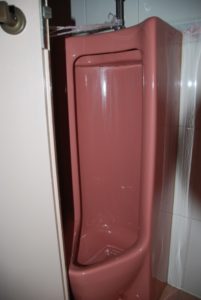
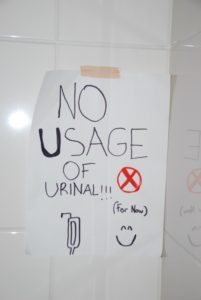 Our friends from school actually have an upright urinal in the their
Our friends from school actually have an upright urinal in the their
bathroom! Their house is an old single family Japanese home with a dual Western bidet toilet and a men’s urinal and there is even a door between the two just like in a public restroom. Both of the toilets are pink too. Their oldest son made a sign for the urinal for all guests who come over. “No usage of urinal!!!”
A few more points about the public restrooms in Japan. Some of them have sanitary waste trash cans that open when you wave your hand over them and also close automatically. There are very few places with toilet seat covers, like in America. The international airport here is one place you can find seat covers. Instead, there’s sanitary seat cleaner, which is a spray that you use with toilet paper to clean the seat yourself. Rarely are there paper towels in which to dry your hands, and consequently not a trash can in sight. Sometimes there are automatic hand dryers (very nice in winter if they blow hot air), but mostly people just bring their own washcloth sized towel in their handbag (or man-bag) to dry their hands.
Occasionally, there are cool bathroom sinks that have every function you need right there, hands free. You put your hands under the faucet to make the water start. You put your hands under the soap dispenser to make soap come out. Then you rinse with the automatic water. Then there is a hole in the opposite side of the sink from the faucet where you put your hands and hot air blows out to dry them. This all-in-one sink function is so cool, more public restrooms should have this.
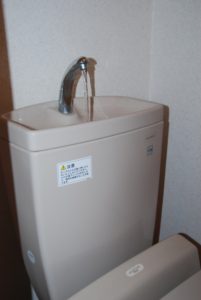
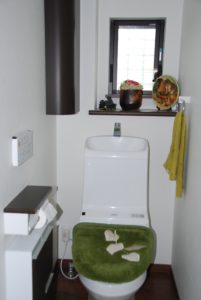 In both toilets in our current house and one in our former house there isn’t even room for a sink in the toilet closet. So, speaking of cool toilet and sink functions, many Western toilets here have a dual toilet flushing and hand washing function. It’s so odd and interesting at the same time. Instead of a lid on the top of the toilet tank, there’s actually a sink with a little faucet there. When you flush the toilet, the toilet bowl fills back up with water, but the water goes back into the toilet tank via the faucet that’s stuck on top of the tank lid. So after you flush, you rinse your hands under this faucet while it fills up the tank. It’s hard to visualize. Hopefully the photos help. Personally, I don’t like washing my hands without soap so I don’t care for this.
In both toilets in our current house and one in our former house there isn’t even room for a sink in the toilet closet. So, speaking of cool toilet and sink functions, many Western toilets here have a dual toilet flushing and hand washing function. It’s so odd and interesting at the same time. Instead of a lid on the top of the toilet tank, there’s actually a sink with a little faucet there. When you flush the toilet, the toilet bowl fills back up with water, but the water goes back into the toilet tank via the faucet that’s stuck on top of the tank lid. So after you flush, you rinse your hands under this faucet while it fills up the tank. It’s hard to visualize. Hopefully the photos help. Personally, I don’t like washing my hands without soap so I don’t care for this.
Moving on from Japan to other places we’ve been in Asia…
Last year we went to KL, aka Kuala Lumpur, Malaysia and Bali, Indonesia. While we were there I had my first encounter with toilet instructions (I’ve since seen this a lot in Japan too). The tourist spots all have Western toilets. The restaurants and shopping malls and most famous landmarks have reliably nice toilet and bathroom areas. But on the outskirts, in the villages, off the beaten paths, you can expect to find the Asian “horizontal urinal.” No toilet paper is common in the jungle and mountains so here’s where the little tissue packets that I’ve been carrying all around come in handy.
In the toilet stalls there are instructions as to how to use the toilet. I’m not sure when the Western toilet was introduced in Asia, but I’m thinking it can’t be that long ago because it seems a lot of places, even upscale locations, have instructions for using the Western toilet properly.
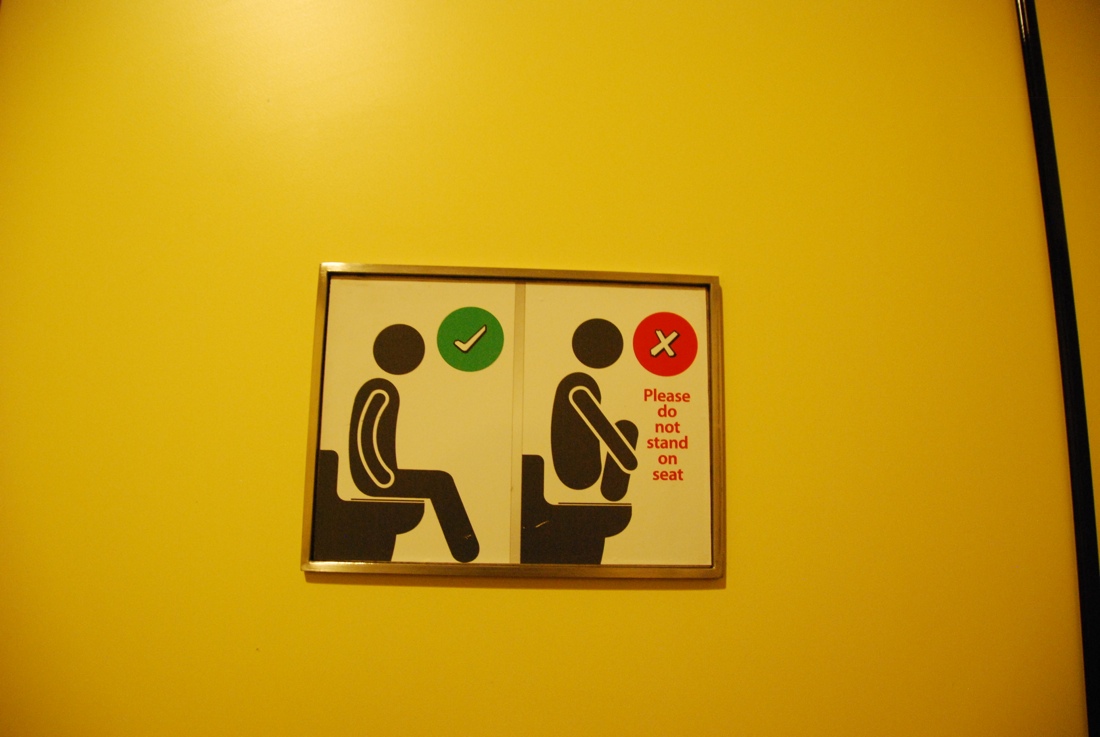 Number one, SIT on the toilet. Do NOT put your feet on the toilet seat. Do not stand on the seat. FLUSH the toilet paper down the toilet. Do not throw used toilet paper in the trash can.
Number one, SIT on the toilet. Do NOT put your feet on the toilet seat. Do not stand on the seat. FLUSH the toilet paper down the toilet. Do not throw used toilet paper in the trash can.
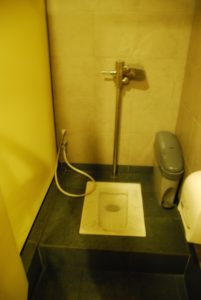
This toilet is from Malaysia. I think it’s a bit blurry because I was in a hurry to take the photo. I felt kind of weird that I was taking a photo of the toilet.
Some toilets with the squatter toilet are on a raised step like this one. To make it easier to squat over the porcelain?
I had a hard time figuring out what the hose, or sometimes faucet spigot, is for in some Southeast Asian toilet stalls. You can see it here on the wall. After talking with other people and seeing it numerous times now, I’ve decided it’s for washing either your body (a very primitive bidet I guess) or it’s to wash down the toilet area for the next person.
In Cambodia, way out in the Angkor temple area, there are not a lot of options for facilities. So when John had to go, our driver took a detour from the direction we were headed, to find a toilet. We had no tissues with us. After we arrived, our guide went off to find something to use. We were both going to use the toilet but after I took one look at them I decided to pass. It was not enough of an emergency for me. However John decided he had an emergency so in he went. These were like a row of little rooms. They were actually fairly spacious as far as toilets go, but quite dirty. Not in the sense that it was messy or people had left it that way, but plainly there was a lot of dirt around and it couldn’t be helped. The horizontal urinal was up on a step and to the right was a large basin/trough of sorts. It looked like a square, tiled bathtub, that was full of water. There was also a plastic bucket with a long handle on the floor.
I watched some people while I waited for John. After they were done they would open the door and use the bucket to scoop water out of the basin and pour it all over the floor and toilet. They scooped that water out about 3 or 4 times to make sure the entire area was washed down. Our guide found wet wipes to use as toilet paper. Since John was in emergency mode I gave him my wet wipe. Our guide was cracking up with laughter, saying, oh it’s number 2! There’s no modern day plumbing here so John told me to ask our guide where to put the wet wipes. Throw them on the pile outside the toilets our guide said. Sure enough, a pile of trash was outside. Ugh. John used a whole water bottle to wash his hands. I was breathing through my mouth for part of this detour. I wasn’t sure if it was safe for my nostrils so I just played it safe. Anyway, going to the “restroom” in this part of the world was often quite an adventure in itself. Halyard has figured out how to hold off all day so that he doesn’t have to encounter any public toilets whatsoever.
When we were in Malaysia we went on a long hike through a jungle, up to a huge waterfall. The toilet at the beginning of our journey was a lot like the one in Cambodia. And again our guide had to find us tissues. And there’s usually no soap in these places. I really require soap when I use the toilet so I was okay with everything except for this missing element. We never strayed too far from the tourist spots in Bali so I can’t think of anything surprising there. Except once when we went on a bike tour through the Bali interior we stopped at a large and famous temple in the center of the island. The temple was holding its monthly celebration so only Balinese people could go on the temple grounds. Our guide said that usually this temple is their bathroom stop on the bike tour, but on this day we were not allowed inside. So we just ate bananas and crackers and drank water and waited for the next pit stop.
Last summer we stayed at the Phi Phi Hotel on Phi Phi Island in Thailand. The hotel’s main bathroom off of the lobby had signs posted above the sinks that read, Do Not Wash your feet in the sink. Who washes their feet in the sink? I asked a few people in Thailand and was told it had to do with Chinese tourists washing their feet in the public sinks. But when I looked it up on the internet it looks like feet washing is also a Muslim custom before prayer. So, Chinese and Muslims are the intended audience? Okay, that’s not really about toilets, but rather about habits in the toilet realm.
Toilet instructions on the stall door can also be found in Japan. I wonder if there are some people in Japan who might not know how to use a Western toilet. This sign here is from a toilet stall door at the clothing store Uniqlo in downtown Osaka. The sign cracks me up.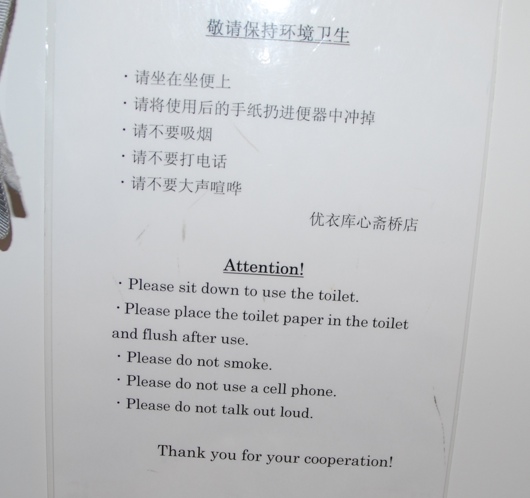
Here’s a toilet sign from the bathroom on Minoh mountain. Google translate says, “Everyone’s toilet let’s use it nicely. Napkin paper diapers are required for waste containers and other garbage is taken home by themselves.” If you are Japanese this makes perfect sense. 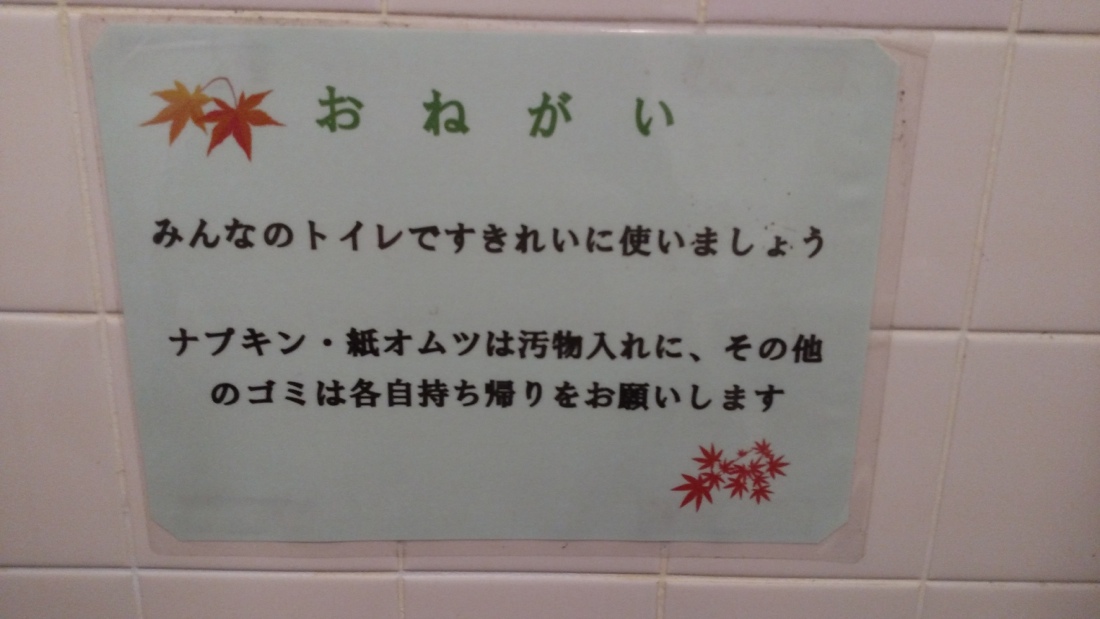 Some of the toilet signs are downright hilarious. Sit! Don’t Stand! Those pictures of the pig below are very large (like 3 feet tall!) and painted on the wall in the toilet area of a local bar near the Minoh train station. The other photo shows decals that are on the toilet lid in the same toilet as the big pig pictures.
Some of the toilet signs are downright hilarious. Sit! Don’t Stand! Those pictures of the pig below are very large (like 3 feet tall!) and painted on the wall in the toilet area of a local bar near the Minoh train station. The other photo shows decals that are on the toilet lid in the same toilet as the big pig pictures.
Below are six toilet paper rolls in the tiny toilet stall at Ichiran, a popular ramen noodle shop. I barely had enough room to turn around in there, but there seems to be plenty of room for six rolls. I guess six toilet paper rolls cuts down on the need to replace them as often? I don’t know but it seems like overkill. You can’t see it but half of them have the end corners folded into triangles.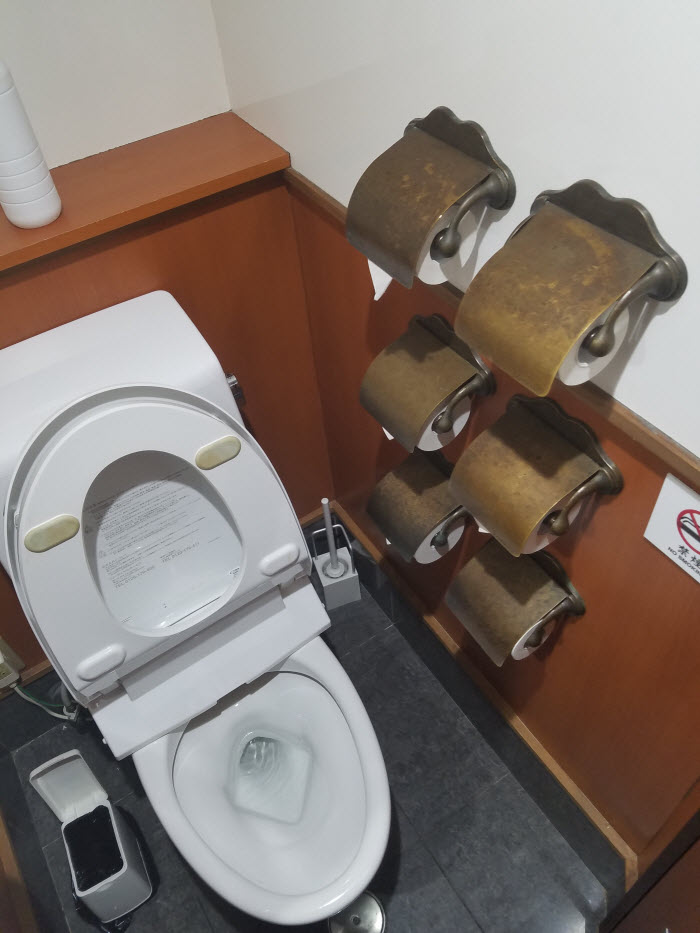 This next photo is the upstairs bathroom in our former house. This is how narrow the tiny room is. This is a photo of the entire area. The sink there on the wall isn’t even big enough to put both hands in there. It’s practically a finger bowl!
This next photo is the upstairs bathroom in our former house. This is how narrow the tiny room is. This is a photo of the entire area. The sink there on the wall isn’t even big enough to put both hands in there. It’s practically a finger bowl!  Anyway, as I’ve mentioned before, the toilet is one of the best places in Japan to warm up in winter. I hope the toilets in our new house have a heated seat function!
Anyway, as I’ve mentioned before, the toilet is one of the best places in Japan to warm up in winter. I hope the toilets in our new house have a heated seat function!
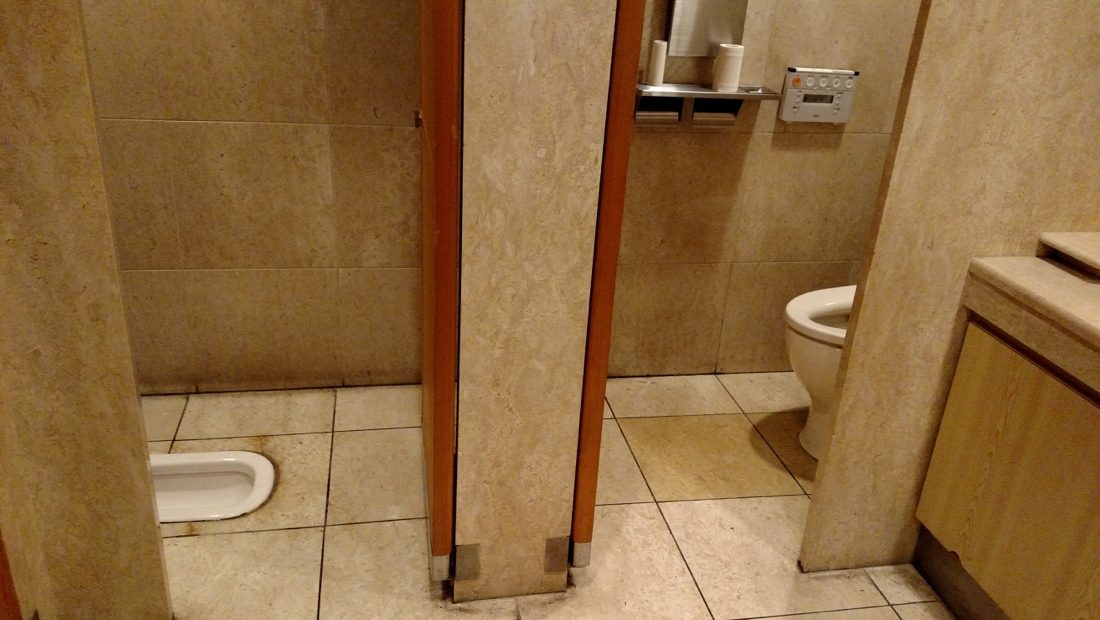
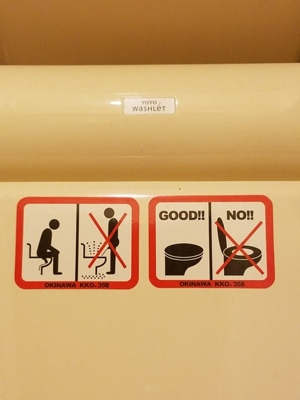
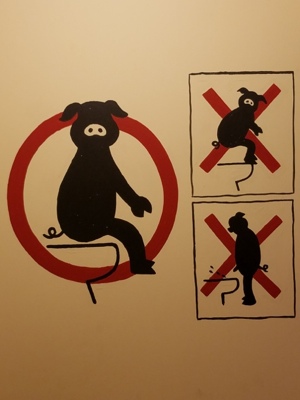
Comments (5)